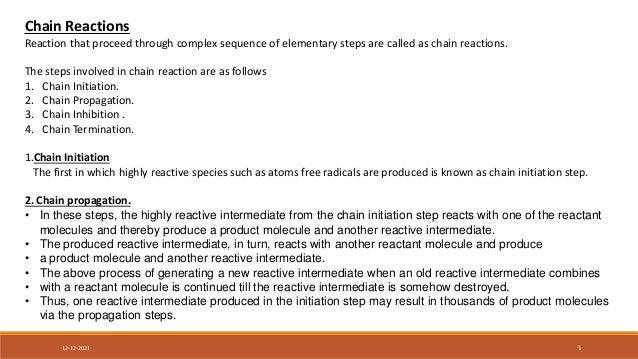
Reactions between hydrogen and bromine
- 1. 12-12-2021 1 Chain Reactions Reaction that proceed through complex sequence of elementary steps are called as chain reactions. The steps involved in chain reaction are as follows 1. Chain Initiation. 2. Chain Propagation. 3. Chain Inhibition . 4. Chain Termination. 1.Chain Initiation The first in which highly reactive species such as atoms free radicals are produced is known as chain initiation step. 2. Chain propagation. • In these steps, the highly reactive intermediate from the chain initiation step reacts with one of the reactant molecules and thereby produce a product molecule and another reactive intermediate. • The produced reactive intermediate, in turn, reacts with another reactant molecule and produce • a product molecule and another reactive intermediate. • The above process of generating a new reactive intermediate when an old reactive intermediate combines • with a reactant molecule is continued till the reactive intermediate is somehow destroyed. • Thus, one reactive intermediate produced in the initiation step may result in thousands of product molecules via the propagation steps.
- 2. 12-12-2021 2 3.Chain Inhibition • In this step, the reactive intermediate combines with a product molecule producing a reactant molecule and another reactive intermediate. • Though a reactive intermediate is generated, the net effect of chain inhibition step is to decrease the rate of overall reaction. 4.Chain Termination. • In this step, the reactive intermediate is destroyed by combining with another reactive intermediate. • This combination may result at the wall of the vessel or by direct collision between the two reactive intermediates within the vessel. • Certain substances when added also help in terminating the reactive intermediates. • For example, nitric oxide molecule can react very rapidly with free radicals and thus may be introduced to remove radicals in a chain reaction. Chain Length • The number of chain propagation steps in between the chain initiation step and termination step is usually expressed as the chain length. • “It can be defined as number of products formed per chain carrier produced in chain initiation phase.” • The chain length depends on the relative rates of chain propagation and chain-terminating step.
- 3. 12-12-2021 3 • Mathematically the chain length may be defined as ratio of rate of formation of products to rate initiation reaction. • i.e. 𝑑 𝑝𝑟𝑜𝑑𝑢𝑐𝑡 /𝑑𝑡 𝑑 𝑖𝑛𝑖𝑡𝑖𝑎𝑡𝑖𝑜𝑛 𝑠𝑡𝑒𝑝 /𝑑𝑡 Kinetics of Chain Reaction • A chain reaction may be classified into two categories 1. Stationary 2.Nonstationary • In general a Chain Reaction may be represented as follows. Initiation R* Propagation R*+A P +αR* Termination R* destruction where R,A and P represent the reactant, radical and product molecules , respectively. If α=1, we have stationary reaction if α >1,the reaction is non stationary. One of the well known examples of stationary chain reaction Is reaction between Hydrogen and Bromine. k1 k2 k3
- 4. 12-12-2021 4 Reaction Between Hydrogen and Bromine H2 + Br2 2HBr Chain Initiation k1 i) Br2 2Br Chain propagation K2 ii)Br +H2 2HBr +H k3 iii)H +Br2 HBr+ Br Chain Inhibition K4 iv)H + HBr H2 + Br Chain Termination K5 v)BR + Br Br2
- 5. 12-12-2021 5 Rate law for the formation of HBr 𝒅 𝑯𝑩𝒓 𝒅𝒕 = k2 [Br] [H2 ]+k3 [H] [Br2] ‒ k4[H] [HBr] Applying using steady state approximation to H and Br 𝑑 𝐻 𝑑𝑡 =0 = k2 [Br] [H2 ] ‒k3 [H] [Br2] ‒ k4[H] [HBr] …. (1) ∴ k2 [Br] [H2 ] = k3 [H] [Br2] + k4[H] [HBr] …. (2) 𝑑 𝐵𝑟 𝑑𝑡 = 0 = k1 [Br2] ‒k2 [Br] [H2 ]+k3 [H] [Br2] + k4[H] [HBr] ‒ k5 [Br]2 ….(3 ) k1 [Br2] =k2 [Br] [H2]‒k3 [H] [Br2] ‒k4[H] [HBr] +k5[Br]2 ….(4) Substituting k2 [Br] [H2 ]from (2) in (4) k1[Br2] = k3[H] [Br2]+k4[H] [HBr] ‒k3 [H] [Br2] ‒k4[H] [HBr] +k5[Br]2 ∴ k1[Br2] = k5 [Br]2 ……(5)
- 6. 12-12-2021 6 k1[Br2] = k5 [Br]2 ∴ k1[Br2] k5 = [Br]2 ∴ [Br] = k1[Br2] k5 𝟏/𝟐 ……..(6) From eq 2 k2 [Br] [H2 ] = k3 [H] [Br2] + k4[H] [HBr] k2 [Br] [H2 ] = [H] ( k3 [Br2] +k4[HBr]) [H] = k2 [Br] [H2 ] ( k3 [Br2] +k4[HBr]) ,……. (7) Substituting eq (6) of [Br] in (7) [H] = k2 k1[Br2] k5 𝟏/𝟐 [H2 ] ( k3 [Br2] +k4[HBr]) = k1 k5 1/2 k2 [H2][Br2] 𝟏/𝟐 ( k3 [Br2] +k4[HBr]) …(8)
- 7. 12-12-2021 7 𝒅 𝑯𝑩𝒓 𝒅𝒕 = 2k3 k1 k5 1/2 k2 [H2][Br2] 𝟏/𝟐 ( k3 [Br2] +k4[HBr]) [Br2] 𝒅 𝑯𝑩𝒓 𝒅𝒕 = 2 (k1/k5)𝟏/𝟐k2k3[H2][Br2] 𝟏/𝟐 k3 [Br2] [Br2] + k4[HBr] [Br2] Divide the numerator and denominator byk3 𝒅 𝑯𝑩𝒓 𝒅𝒕 = 2 (k1/k5)𝟏/𝟐k2k3/k3[H2][Br2] 𝟏/𝟐 k3 k3 + k4[HBr] k3[Br2] 𝒅 𝑯𝑩𝒓 𝒅𝒕 = 2 (k1/k5)𝟏/𝟐k2[H2][Br2] 𝟏/𝟐 1+ k4[HBr] k3[Br2] Let 2 (k1/k5)𝟏/𝟐 /k2 = k′ and k4 k3 = k″
- 8. 12-12-2021 8 Rate law for the formation of HBr 𝒅 𝑯𝑩𝒓 𝒅𝒕 = k2 [Br] [H2 ]+k3 [H] [Br2] ‒ k4[H] [HBr] Since from eq (2) k2 [Br] [H2 ] = k3 [H] [Br2] + k4[H] [HBr] Substituting in rate law 𝒅 𝑯𝑩𝒓 𝒅𝒕 = k3 [H] [Br2]+k4[H] [HBr] + k3 [H] [Br2] ‒ k4[H] [HBr] ∴ 𝒅 𝑯𝑩𝒓 𝒅𝒕 =2 k3 [H] [Br2] Substuting [H] from eq (8) [H] = k1 k5 1/2 k2 [H2][Br2] 𝟏/𝟐 ( k3 [Br2] +k4[HBr]) ∴ 𝒅 𝑯𝑩𝒓 𝒅𝒕 = 2 k3 k1 k5 1/2 k2 [H2][Br2] 𝟏/𝟐 ( k3 [Br2] +k4[HBr]) [Br2]
- 9. 12-12-2021 9 𝒅 𝑯𝑩𝒓 𝒅𝒕 = k′ [H2][Br2] 𝟏/𝟐 1+k″ [HBr] [Br2] [HBr] [Br2] appears in the denominator HBr inhibits the reaction by undergoing reaction (iv) and Br2reduces the amount of inhibition in reaction. (iii). Br2 and HBr are competing with one another fro hydrogen atoms. In initial state HBr is negligibly small so [HBr] =0 1+k″ [HBr] [Br2] =1 And initial rate becomes. ∴ 𝒅 𝑯𝑩𝒓 𝒅𝒕 = 2k′ [H2][Br2]𝟏/𝟐 total order of the reaction is 1+ ½ =3/2 = 1.5